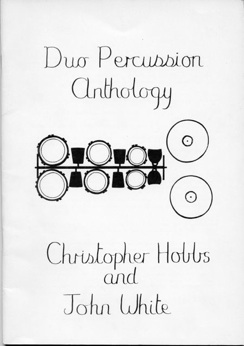OEMC0001. Christopher Hobbs and John White. Duo Percussion Anthology.
- Facsimile of original EMC document. A4, card-covered; 28 pp. £5 + p & p.
- The original EMC Anthology of pieces by Christopher Hobbs and John White. A study score size.
About the Duo Percussion Anthology
The Hobbs-White Duo Percussion Anthology contains music for the following instrumentation:
- Bells: (8) (cow bells or camel bells according to piece)
- Blocks: (8) (2 sets of temple blocks — 4 large Korean blocks, 4 miniature chime blocks, according to piece)
- Drums: (4) (Small tom-toms or large roto-toms)
- Cymbals: (2) (suspended cymbals, of good quality)
The Anthology includes the following pieces, some of which link to Hobbs and White’s performance at the Whitechapel Gallery, 10 June 1973:
Christopher Hobbs: A Fair Lick
John White: Photo-Finish Machine
Hobbs: Lincoln E. Moses comes down from the mountain
White: Purple Passage
Hobbs: Steady Pace Journey
White: Yet Another Exercise
Hobbs: Timpani Studies
For the whole concert in order, see here.
About the Hobbs-White Duo, Systems and Readymades
After the great systems quartet, the Promenade Theatre Orchestra, broke up (you can find out more about them here), Christopher Hobbs and John White needed to fulfil some performance obligations and so decided to work together. Structurally and instrumentally this move to a duo marked a sharp change in instrumentation and musical techniques.
The PTO was a group that played toy pianos and reed organs. Reed organs were the kind of household instrument your gran may have had. They had a limited range, chord buttons, and a sound quite like a harmonica, as air was pumped through metal reeds. They also played their own instruments (clarinet, bassoon, oboe, and tuba) and a wide range of percussion instruments. Their music ranged from musical borrowings or transcriptions (as in Hugh Shrapnel’s arrangement of Carolina Moon, or Alec Hill’s great use of change ringing for Large Change Machine), to readymades (a type of compositional system in which the structure is taken from an existing process and applied to the notes of the piece, as in Hobbs’ Aran), to systems composition using random means to create the structure (many of John White’s Machine processes).
The Hobbs-White Duo took the random systems and readymade processes for their new work, adding what might be called ‘strict systems’, in which the note-to-note procedure is determined by mathematical number systems. Strict systems are rigorous, and best applied to duration, so that Hobbs and White began their duo work as an unpitched percussion duo. The first of these strict systems percussion pieces was Hobbs’ Number Piece 1.
The Hobbs-White Duo only performed unpitched strict systems for a short time, moving later to piano duo and for their secondary instruments (bassoon and tuba/trombone). The Hobbs-White Duo Percussion Anthology contains pieces from this time. Some of them are strict systems, like White’s Photo-Finish Machine. Others, like Hobbs’ Timpani Studies are readymades or they are random systems. These pieces are all useful short pieces to include in any concert that would normally feature Steve Reich’s Clapping Music or Music for Pieces of Wood.
Virginia Anderson
If you are interested in any of the above, e-mail questions**experimentalmusic.co.uk (for the **, substitute @) for postage costs or to notify us of your interest in pdf scores. Payment is made electronically by Paypal; please specify whether you would like a faster or slower delivery of your goods. Because of fluctuating exchange rates, do e-mail us for current prices in any other currency than UK sterling, although we do recommend sterling payments as the most economical way of paying.

